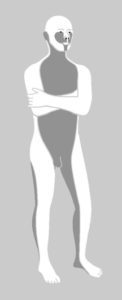I previously wrote about receiving energy from a partner/opponent using a ball (elastic sphere) analogy. This article addresses attacking a partner/opponent’s defensive “sphere” using an (按 press or push) and ji (挤 squeeze), two of the thirteen energies/techniques (十三式 shi san shi) of Taijiquan (太極拳).
A sphere can be attacked in two ways; by controlling its surface (an), or by penetrating its surface (ji). This approach to understanding the energies of an and ji is very general and most interactions attacking a training partner or opponent can be described using this approach. Although this approach is unorthodox, hopefully it will be compatible enough with readers’ understandings to be of use.
 A useful analogy for understanding an and ji is an overstuffed suitcase that is difficult to close due to clothing protruding outside the opening. To close the suitcase, one would need to press down (an) on the top of the suitcase while poking the clothing into the crack (ji) until the suitcase can be closed fully. While an is pressing or pushing against the solid substance of the suitcase, ji would be squeezing into cracks, gaps, or weak places; in this case, the suitcase opening.
A useful analogy for understanding an and ji is an overstuffed suitcase that is difficult to close due to clothing protruding outside the opening. To close the suitcase, one would need to press down (an) on the top of the suitcase while poking the clothing into the crack (ji) until the suitcase can be closed fully. While an is pressing or pushing against the solid substance of the suitcase, ji would be squeezing into cracks, gaps, or weak places; in this case, the suitcase opening.
 Another way of explaining this is that an would attack the partner/opponent through their dorsal or yang (阳) surfaces, whereas ji would attack them by squeezing past their yang defensive surfaces and into their ventral or yin (阴) surfaces. In the illustration, the yin (ventral) surfaces are depicted with the dark gray and the yang (dorsal) surfaces are white.
Another way of explaining this is that an would attack the partner/opponent through their dorsal or yang (阳) surfaces, whereas ji would attack them by squeezing past their yang defensive surfaces and into their ventral or yin (阴) surfaces. In the illustration, the yin (ventral) surfaces are depicted with the dark gray and the yang (dorsal) surfaces are white.
Yin surfaces are generally those that are covered when in the fetal position, and yang surfaces are those that are exposed and tan quickest from normal activity sun exposure. In many animals most yin surfaces are white (e.g., squirrels, deer) whereas most yang surfaces have colored fur.
The yang surfaces contain the extensor muscles which function to extend the joints and are typically used to issue force, or to resist or repel incoming force. The yin surfaces contain the flexor muscles which function to bend the joints and to pull or absorb an opponent’s force.
Attacking through the yang surfaces can be used to produce resistance in the partner/opponent and tends to lock their structure, allowing one to connect to their spine (or their center) in order to move and control them. Attacking through the yin surfaces can be used to collapse and penetrate their structure. Attacking through the yin surfaces makes it difficult for the opponent to counter, since the muscles located on the yin surfaces function opposite to what would be needed to push away the incoming energy.
The children’s playground trick of bumping the backs of someone’s knees and causing their legs to buckle is an example of using ji to attack the yin. One could instead attack the yang to topple someone by attacking their knees from the front using an, like making a football tackle.
Taijiquan seeks to avoid having protrusions (凸 tu, convex/to stick out/protrude) or indentations (凹 ao, a depression/indentation/concave/hollow). We seek to be smooth like the surface of a sphere (圆 yuan, rounded), without bumps or pits for our partner/opponent to catch hold of and exploit. Conversely, we want to take advantage of the lack of roundness of our partner/opponent.
One saying is:
毋使有缺陷處,毋使有凸凹處
“Do not allow any defects or deficiencies; do not allow any protrusions or hollows” [from the Taijiquan Classic attributed to Zhang Sanfeng 張三丰, as translated by Lee Fife (2016)].
Tu (“protrusions”) and ao (“hollows”) are ways of stating that there are excesses or deficiencies; or imbalances in yin and yang. An could be viewed as attacking an opponent’s tu (their yang excess, i.e. protrusions), while ji would attack their ao (their yin deficiency, i.e. hollows).
Xu (虚 empty or insubstantial) and shi (实 full or substantial) are two other terms that are used to describe yin and yang qualities in Taijiquan. Ji would attack through the opponent’s xu, while an attacks their shi.
If we use the water analogy that is frequently associated with Taijiquan, an would act like water pushing against the surface of a boulder and disturbing or dislodging it, for example, whereas ji would flow around the hard surface structures to penetrate and erode the softer areas as well as seeping into cracks and fissures to destroy the boulder from the inside.
Against a partner/opponent, ji could squeeze into the gap between the partner/opponent’s arms as is demonstrated in common push-hands drills. It could also penetrate into the gap between an arm and the torso, or into the weak (yin) side of joints (the gaps between bones), or into other weak places not defined by the opponent’s arm positions (e.g., the throat, the stomach, between the legs, etc.).
An has the mass or pressure of the practitioner’s body behind it. Ji crowds the partner/opponent by squeezing close through weaknesses (gaps, cracks, etc.). Both methods displace the partner/opponent since two objects cannot occupy the same space, but they are applied differently.
Pages: 1 2